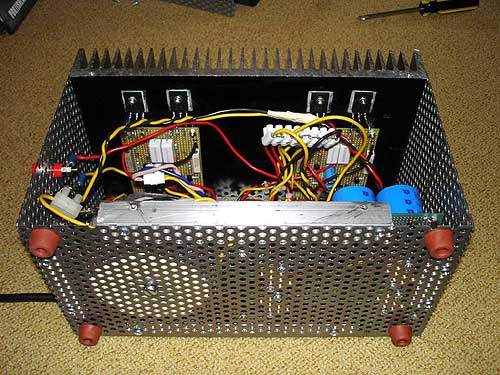Rudy van Stratum(amini-p6)
Miscellaneous Projects
diy-gallery of my mini-Amplifier
I followed the discussion about the Zen and A's for several years. But only as an observer, not intending to build one myself immediately. I hesitated because of the power dissipation of the bigger amplifiers and because I do not have very good experiences with the sound quality mosfets in general.
Now I decided that I wanted to hear it all for myself. In the Netherlands there is a very nice supplier that has pcb's and all components needed including a very handsome case to put it in for a reasonable price. I just build the A3 in this manner.
It all works flawless from the start. The first few days it only sounded normal, not extraordinary. Only after a few weeks of burning in the amp started to sing. I am not sure though if the amp really outperforms my usual benchmarks (some Hiraga's and some small tube amps). I am a person that wants to fiddle around and try this and that.
The case and lay-out of my A3 are not very well suited to do experiments. Just for that purpose I decided to make a 'try and test' version of the mini-A. I use normal grade components: some Dale resistors and some Beyschlag resistors, Philips capacitors, irf1610 and irfp240 mosfets. I made a breadboard by hardwiring the components directly to each other.
The sound is very much like the other A3. Everything worked for the first time, no hiss, no hum. And again the amp needs to burn in for some time (do other people have this same experience, or am I fooling myself?). In the first days the sound is a little too dark and shut-in, the highs are not freeing themselves from the speakers etc. As you see there is no cabinet or case yet, just a cooling device (around 0,3 C/W) with the boards on it, some wires and a simple power supply (CRC, both channels sharing the same supply).
I intend to experiment with other mosfets (irfp140, since irfp044 is not easily obtainable), with different voltages and idle currents (now around 15 Volts and 1 amp). Sure, many people have done this but I want to see for myself and my situation. Without doubt this is a very special amplifier: easy to build, it is a very simple and original and robust circuit, no points of manual adjustment, it is not critical for parts quality (I think), it has a stable offset of around 50 mV or less and, before I forget, a very good sound. The sound is not clinical (as were the other mosfet-amps I tried) but more on the warm side of neutral with smooth highs. But very good is not good enough, I have yet to find out if the amp outperforms other (small transistor) star-amps as the John Linsley Hood (2003 edition) and the 20 Watt Hiraga. It just is too early for me to make that final judgment.
Rudy van Stratum The Netherlands











